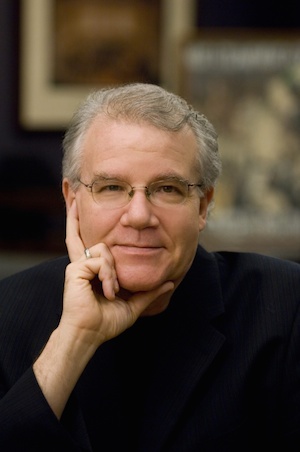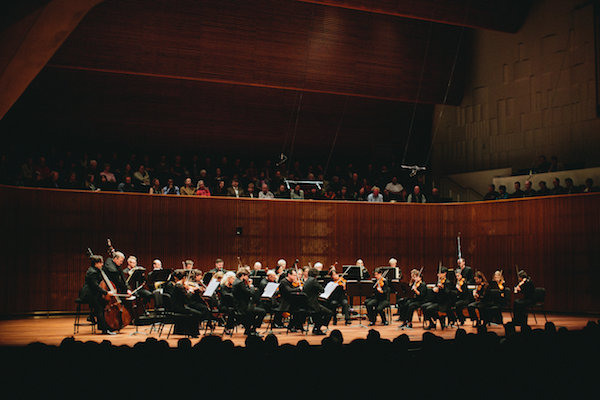
Experimenting and giving permission to fail: an orchestra prepares for the future
By Levi Weinhagen, St Paul arts blogger Bruce Coppock, photo courtesy SPCO
Over the past 15 years, the St. Paul Chamber Orchestra (SPCO) has gone through a host of transitions – from giving over artistic direction to its own musicians to inaugurating a new concert hall to rave reviews earlier this month. During that time, the orchestra’s President and Managing Director Bruce Coppock has gone through his own personal and professional transitions, including losing the ability to play the cello after a car accident, and having to leave his position at the orchestra for several years due to a battle with cancer. We caught up with Coppock just days after the first performance at the new hall to talk about how his own views on creating the orchestra of the future. LW: The new concert hall is one of those fun changes, but there must also be a lot of work surrounding that. BC: It’s about 15 years in the making. What’s been fantastic about it is that it’s been a real community effort to get together. I think it’s probably a foundation’s dream to see organizations working closely together. And that’s what happened with the Ordway and the Schubert club and the MN Opera and the SPCO. It was a huge collaboration. And everybody wins in this. Everybody gets more space and better space for their art forms.
LW: You have been intentionally bringing in new kinds of music. Has that worked in the ways you had hoped? BC: We do things by consensus in the Arts Partnership, and there was unanimous agreement that it couldn’t just be about European concert music. It needed to be about a broader array of genres and we hope that these programs will just be the beginning. We hope that the broader community, beyond the traditional orchestra recital and opera audience, will see the Ordway in a different light. The lower cost of being in the concert hall should open up the Ordway as a facility to an awful lot of organizations that otherwise it was not possible to schedule there for the combination of just sheer density of what was already scheduled by the resident arts organizations, and the cost, and the appropriateness of the facility. So, it’s kind of a trifecta that we hope will seriously change the community’s perception of what the Ordway is and who it’s for.
LW: You’ve seen this organization through financial challenges, organizational challenges, and changing homes, all with an embrace of the idea that you have to change and progress to stay vibrant and healthy. How much of that is informed by the injuries and health challenges you’ve gone through? BC: I think, initially, when I made the move from playing the cello for a living to doing management for a living, the car accident that precipitated that really, quite frankly, just accelerated something that would have happened within the next 10 years in any case. I knew as soon as I looked down at my hand in the car that day that it was over. But, I’m blessed with a very much glass half full attitude toward things. So, it didn’t take too long for me to start focusing on what kind of opportunities the required change presented. And when I got sick in 2006 I would say that really fundamentally changed my outlook on things. On the work we do. When you really come face to face with your own mortality, it changes the conversation materially. I think there are some people who are consumed with needing to get stuff done before they die. I didn’t feel that way. I think it broadened my perspective. It made me think about what we do as artists in a broader context. A very close musician friend said to me, “God, it’s just so tragic what’s happened to you. First you lost your hand and now you have cancer. It’s so tragic.” And I said, “wait a minute. If I die tomorrow, I will have had 56 great years. I’ve never been hungry a day in my life. I got to spend my life making music and creating the circumstances under which music can get made. And I’ve had fantastic experiences, a fantastic life and a great family and I’ve seen my kids grow up.” Syria is a tragedy. The health, or lack thereof, of a lucky white guy in America is hardly the stuff of tragedy. With respect to the SPCO, it’s emboldened me to think that the SPCO needs to be even more daring. The achievement of the concert hall is fantastic, don’t get me wrong, but ultimately all it is is a tool to make for better experiences for audiences and better experiences for artists and to create new opportunities for art to be made and for people to develop their skills. It’s not the goal. It’s the track and train that rides on the track.
LW: Where you surprised to find yourself back at the SPCO? BC: I remember in the late summer of 2008 hoping that I’d live to see Obama get elected. My timeframe was pretty narrow. I was given three months to live. It took a while to allow myself to embrace a longer timeline. If you told me in 2009 that I was going to sit in the concert hall in 2015 and the New York Times was going to rave about it and the community was going to be thrilled and blah, blah, blah I would have thought that all sounds great but I won’t be there.
LW: As someone in a leadership position, has your departure due to this illness affected your interpersonal relationships with colleagues and people with whom you’re partnering? BC: It’s kind of hard to separate the process of maturing and aging from the process of gaining perspective from my peculiar circumstances, but I’d like to think I’m more empathetic than I was before. I’d like to think that I am more open to diverse ways of thinking. Now we have this fantastic opportunity with the new concert hall and, for a combination of reasons, the opportunity to hire a bunch of new players, and it’s really a definitional moment. There are very few cultural organizations that are given a chance to redefine themselves in a wholesale way. And that’s what the SPCO has created for itself. We need to set these organizations up for the world that’s going to be, not the world that was. You can only conserve tradition for so long.
LW: If you’re trying to create space for the next generation, how do you lead while also trying to get out of the way? BC: Kyu-Young Kim, director of artistic planning who is also a member of the orchestra, he’s a lot younger than I am and there’s a reason why he spoke to the opening audience the other night instead of me. He represents the future. The guys who were onstage the other night in leadership positions are in their 30s and 40s and they had a big say in what happened onstage. Sure, I provided a little guidance here and there, but ultimately they own it, ultimately they did it. I think it’s the yin and yang of pushing when you need to push, keeping the organization on the tracks if there’s some wildly hair-brained scheme, but also letting people do what they want to do. That’s what art is all about. Beethoven would not be Beethoven if he did not break every rule in the book. Sometimes trustees will say, “how do we know that this is going to work?” If we knew something was going to work, we wouldn’t be discussing whether to try it or not. It’s all about finding the right balance between sure-fire success and trying new stuff. I have a particularly clear view of my role. I’m supposed to be the creative disruptor. And if I’m not, nobody will be. That’s partially because that’s the way I understand the SPCO’s role in the music business. This community already has a great bricks and mortar symphony orchestra. It doesn’t need another one. Think about the Twin Cities without the Walker, think about it without the Wiesman, think about it without the Russian Museum. If all we had was the Minneapolis Institute of Arts, the Twin Cities would be great, but it would be a pretty one-dimensional town. But it doesn’t need two MIAs. The challenge for the SPCO is to have the courage to define itself on its own terms, not in referential terms toward our wonderful sister institution in Minneapolis. Part of what the SPCO has always been about and what its success has always been is living a little closer to the edge. That’s where the SPCO became the SPCO, in the 70s when Dennis Davies was the music director. The Twin Cities was an absolute magnet for every major living composer. They came to the Twin Cities to be with the SPCO. Stockhausen, Berio, Copeland, Cage, etcetera. They were all here regularly. About 12 years ago, we were experiencing a really terrifying and precipitous decline in attendance. We scratched our heads and worried. And then we did two radical things. The first was we distributed ourselves even more widely throughout the metropolitan area. We started a series in Mahtomedi and Stillwater and Apple Valley and practically overnight they were sold out. So that expanded the audience. And the other thing we did is some test marketing and it was clear there was an inverse relationship between price and people’s willingness to attend. So we did a radical thing and lowered our ticket prices dramatically, by about 50 percent. And the result is that, in an industry that overall has seen a 29 percent decrease in attendance, we’ve seen a 40 percent increase in attendance. Last year, we sold more tickets to the SPCO than we’ve ever sold in the history of the organization. When we started it, people called me up from around the country and said, “are you out of your mind?” But, it costs so much more to sell a $75 ticket than a $40 ticket, let alone a $10 ticket. The net from ticket sales has increased by half a million dollars. The gross is lower but the net is higher, so that’s a good thing. I think people who run organizations like ours need to be willing to try new stuff and give themselves permission to fail. That’s the way progress gets made, through failures. Successes and failures.

The St. Paul Chamber Orchestra
Recent Content
-
Artsarticle ·
-
Artsarticle ·
-
Artsarticle ·
